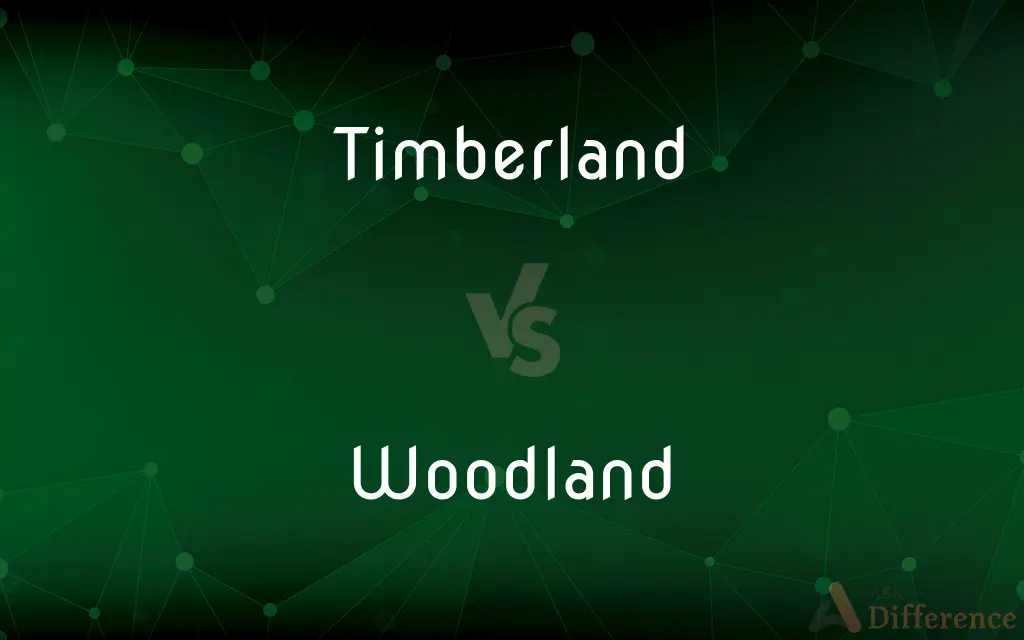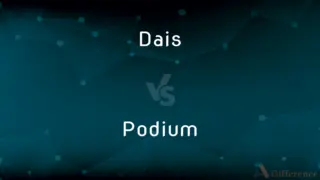Timberland vs. Woodland — What's the Difference?
Edited by Tayyaba Rehman — By Urooj Arif — Updated on March 12, 2024
Timberland is land managed for timber production, while woodland is an area with dense trees and natural growth.

Difference Between Timberland and Woodland
Table of Contents
ADVERTISEMENT
Key Differences
Timberland refers to forests or tracts of land primarily managed for the production of timber and other wood products. These areas are often carefully managed with practices such as planting, thinning, and harvesting to ensure sustainable yields and economic returns. Woodland, on the other hand, describes a lower-density forest area, typically characterized by a mix of trees, shrubs, and underbrush, and is not primarily managed for timber production. Woodlands can serve various purposes, including conservation, recreation, and habitat provision.
The management of timberland is often guided by forestry principles, focusing on maximizing the production of wood for commercial use, which includes lumber, paper, and other wood-derived products. In contrast, woodlands may be managed with a broader set of objectives, including ecological conservation, biodiversity, and recreational use, without a primary focus on wood production.
Timberland areas are typically more uniform in their tree species composition and structure, due to the practices of silviculture that promote certain species for commercial purposes. Woodlands tend to have a more diverse ecosystem, with a wider variety of plant and animal species due to their less intensive management and the natural evolution of the area.
Investments in timberland are often considered by investors looking for long-term returns from timber harvesting, land appreciation, and sometimes for conservation and carbon sequestration credits. Woodlands, while they can also be privately owned, are often valued for their natural beauty, wildlife habitat, and recreational opportunities, rather than for their potential timber yield.
Understanding the distinction between timberland and woodland is crucial for land management, conservation efforts, and investment decisions. While both are important for their environmental and economic roles, their management and conservation priorities differ significantly.
ADVERTISEMENT
Comparison Chart
Primary Use
Timber and wood products production
Natural growth, habitat, recreation
Management
Intensively managed for timber yield
Managed for conservation, recreation, or not at all
Tree Density
Often uniform and plantation-like
Mixed, with a more diverse ecosystem
Biodiversity
Lower due to focus on certain tree species
Higher due to varied species and less intensive management
Economic Role
Investment for timber production and land appreciation
Valued for ecological, recreational, and aesthetic qualities
Compare with Definitions
Timberland
Land managed for timber harvesting.
The timberland was carefully managed to sustainably produce lumber.
Woodland
Less intensively managed, with a focus on ecological values.
Local woodlands are preserved for their biodiversity and recreational value.
Timberland
Emphasizes economic return from wood products.
Investors in timberland often focus on the long-term yield of timber.
Woodland
Areas characterized by natural tree growth.
The woodland area is popular for hiking due to its natural beauty.
Timberland
Managed through practices like planting and thinning.
Thinning practices in timberland ensure the healthiest trees grow more robustly.
Woodland
Recreational and aesthetic values are significant.
The community values the woodland for its trails, scenic views, and tranquility.
Timberland
Investment opportunities in timberland focus on resource production.
Timberland investments are attractive for their potential in resource yield and land value appreciation.
Woodland
Often serves as important habitats for wildlife.
Woodlands provide crucial habitats for many native animal species.
Timberland
Can contribute to conservation through sustainable management.
Sustainable timberland management can also support wildlife habitats.
Woodland
Features a mix of tree species, underbrush, and wildlife.
The diverse ecosystem in the woodland supports a variety of bird species.
Timberland
Forested land, especially land containing timber of commercial value.
Woodland
A woodland ( (listen)) is, in the broad sense, land covered with trees, or in a narrow sense, synonymous with wood (or in the U.S., the plurale tantum woods), a low-density forest forming open habitats with plenty of sunlight and limited shade (see differences between British, American, and Australian English explained below). Woodlands may support an understory of shrubs and herbaceous plants including grasses.
Timberland
Forested land thought of in terms of its potential and value as timber.
Woodland
Of or relating to a Native American culture prevalent throughout much of eastern North America beginning around 1000 BC and lasting especially in northeastern regions until contact with Europeans, characterized by increasing reliance on settled agriculture, by the development of Neolithic crafts and tools, and in certain areas by the building of ceremonial mounds.
Timberland
Land that is covered with trees and shrubs
Woodland
Of, relating to, or constituting woodland.
Woodland
Living, growing, or present in woodland
Woodland flowers.
Woodland
Land covered with trees.
Woodland
Of a creature or object: growing, living, or existing in a woodland.
The woodland creatures ran from the fire.
Woodland
(obsolete) Having the character of a woodland.
Woodland
Land covered with woody vegetation.
Woodland
Land covered with wood or trees; forest; land on which trees are allowed to grow, either for fuel or timber.
Here hills and vales, the woodland and the plain,Here earth and water seem to strive again.
Woodlands and cultivated fields are harmoniously blended.
Woodland
Of or pertaining to woods or woodland; living in the forest; sylvan.
She had a rustic, woodland air.
Like summer breeze by woodland stream.
Woodland
Land that is covered with trees and shrubs
Common Curiosities
What defines woodland?
Woodland refers to an area with dense trees and natural vegetation, not primarily managed for timber production.
What is timberland?
Timberland is land primarily used and managed for the production of timber and other wood products.
What economic benefits do timberlands offer?
Timberlands provide economic benefits through timber harvesting, land appreciation, and sometimes carbon credits.
Are all forested areas considered timberland?
Not all forested areas are considered timberland; only those managed primarily for timber production fall under this category.
What are the key features of a woodland?
Key features of a woodland include natural tree growth, biodiversity, and often a focus on conservation or recreation.
Can timberland be converted into woodland?
Yes, timberland can be converted into woodland through natural succession or deliberate conservation efforts, though it may take many years.
How does biodiversity in timberland compare to woodland?
Biodiversity in timberland is often lower due to the focus on certain tree species and intensive management, whereas woodlands usually have higher biodiversity.
How is timberland managed?
Timberland is managed through forestry practices aimed at sustainable wood production, such as selective cutting and replanting.
Why are woodlands important for the environment?
Woodlands are important for maintaining biodiversity, providing wildlife habitats, and offering ecosystem services like carbon sequestration.
What recreational activities are common in woodlands?
Common recreational activities in woodlands include hiking, birdwatching, and nature photography.
Share Your Discovery

Previous Comparison
Dais vs. Podium
Next Comparison
Deem vs. SeemAuthor Spotlight
Written by
Urooj ArifUrooj is a skilled content writer at Ask Difference, known for her exceptional ability to simplify complex topics into engaging and informative content. With a passion for research and a flair for clear, concise writing, she consistently delivers articles that resonate with our diverse audience.
Edited by
Tayyaba RehmanTayyaba Rehman is a distinguished writer, currently serving as a primary contributor to askdifference.com. As a researcher in semantics and etymology, Tayyaba's passion for the complexity of languages and their distinctions has found a perfect home on the platform. Tayyaba delves into the intricacies of language, distinguishing between commonly confused words and phrases, thereby providing clarity for readers worldwide.














































